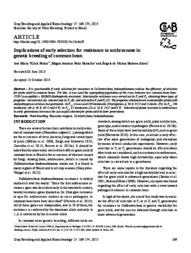Implications of early selection for resistance to anthracnose in genetic breeding of common bean.
Implications of early selection for resistance to anthracnose in genetic breeding of common bean.
Author(s): ABREU, A. de F. B.
Summary: It is questionable if early selection for resistance to Colletotrichum lindemuthianum reduces the efficiency of selection for grain yield in common beans. For this, it was used the segregating population of the cross between two common bean lines: CI107 (susceptible) x BRSMG Madrepérola (resistant). Selection for resistance was carried out in F2 and F3, obtaining three types of progenies: not selected (A), selected only in F2 (B), and selected in F2 and F3 (C). The progenies obtained were evaluated for grain yield and pathogen occurrence in experiments. In F3:5, it was used 289 treatments (96 progenies A, 96 B, 95 C and 2 checks (T)); in F3:6, 196 treatments (64 A, 64 B, 64 C and 4 T); in F3:7, 81 treatments (26 A, 26 B, 26 C and 3 T). Selection of plants resistant to anthracnose in early generations increases the successful selection for grain yield in later generations.
Publication year: 2015
Types of publication: Journal article
Unit: Embrapa Rice & Beans
Observation
Some of Embrapa's publications are published as ePub files. To read them, use or download one of the following free software options to your computer or mobile device. Android: Google Play Books; IOS: iBooks; Windows and Linux: Calibre.
Access other publications
Access the Agricultural Research Database (BDPA) to consult Embrapa's full library collection and records.
Visit Embrapa Bookstore to purchase books and other publications sold by Embrapa.

